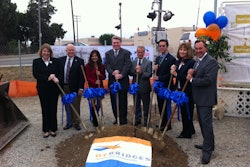U.S. Transportation Secretary Ray LaHood took a firsthand look at “connected vehicle” technologies that have the potential to improve safety and help drivers avert crashes as part of a research clinic hosted by the Department of Transportation at Walt Disney World SPEEDWAY.
“Thanks to the efforts of automakers and the safety community traffic fatalities have reached historic lows,” LaHood said in a press statement. “Despite these great strides though, more than 32,000 people are still killed on our nation’s roads every year. That’s why we must remain vigilant in our effort to improve safety.”
LaHood says the research should be an integral part of the next “major safety breakthrough.”
Analyses by the National Highway Traffic Safety Administration (NHTSA) show connected vehicle technology could potentially impact approximately 80 percent of vehicle crash types involving non-impaired drivers, according to the U.S. DOT.
Specifically, the U.S. DOT says that NHTSA research shows these technologies could help prevent a majority of kinds of crashes that typically occur in the real world such as crashes at intersections or while switching lanes.
The four-day “Driver Acceptance Clinic” at Walt Disney World SPEEDWAY in Orlando is part of a six-month program that includes similar research clinics across the nation. The driver clinics are the first phase of a two-part research program jointly developed by the Department’s National Highway Traffic Safety Administration and Research and Innovative Technology Administration (RITA) in coordination with other U.S. Department of Transportation agencies.
The driver clinics are designed to evaluate cars equipped with “vehicle-to-vehicle” communications systems in a controlled environment where researchers can observe the drivers’ responses. The technologies being tested include in-car collision warnings, “do not pass” alerts, warnings that a vehicle ahead has stopped suddenly, and other similar safety messages.
“With its potential to save lives and prevent injuries, connected vehicle technology could be a real game-changer for vehicle safety,” said NHTSA Administrator David Strickland in a written statement. “These clinics are vital to understanding how drivers will respond to the technology and how connected vehicles communicate in real world scenarios.”
RITA Acting Administrator Greg Winfree said in the same press statement: “The past several decades of auto safety have been dedicated to surviving crashes, but the future will be about avoiding crashes. That is what connected vehicles are all about. Moreover, the entire Safety Pilot is about connecting the best resources from public and private sectors to achieve the most effective results possible.”
Driver clinics have already been held in Michigan and Minnesota, and future clinics are planned for Virginia, California, and Texas and are expected to conclude by January 2012. Following the clinic program, the Department of Transportation will launch the second part of the Safety Pilot with a model deployment that will use approximately 3,000 vehicles to further test connected vehicle technology in a year-long effort from summer 2012 through summer 2013. The model deployment will operate on roads in Ann Arbor, Michigan and test a limited number of vehicle-to-infrastructure applications in addition to continuing the research on vehicle-to-vehicle communication systems.
Eight major automotive manufacturers are providing support for the Department’s research through partnering agreements: Ford Motor Company, General Motors LLC., Honda R&D Americas, Inc., Hyundai-Kia America Technical Center, Inc., Mercedes-Benz Research and Development North America, Inc., Nissan Technical Center North America, Inc., Toyota Motor Engineering & Manufacturing North America, Inc. and Volkswagen Group of America.
The information collected from both phases of the Safety Pilot will be used by NHTSA to determine by 2013 whether to proceed with additional vehicle-to-vehicle communication activities, including possible future rulemakings, according to the U.S. DOT.













